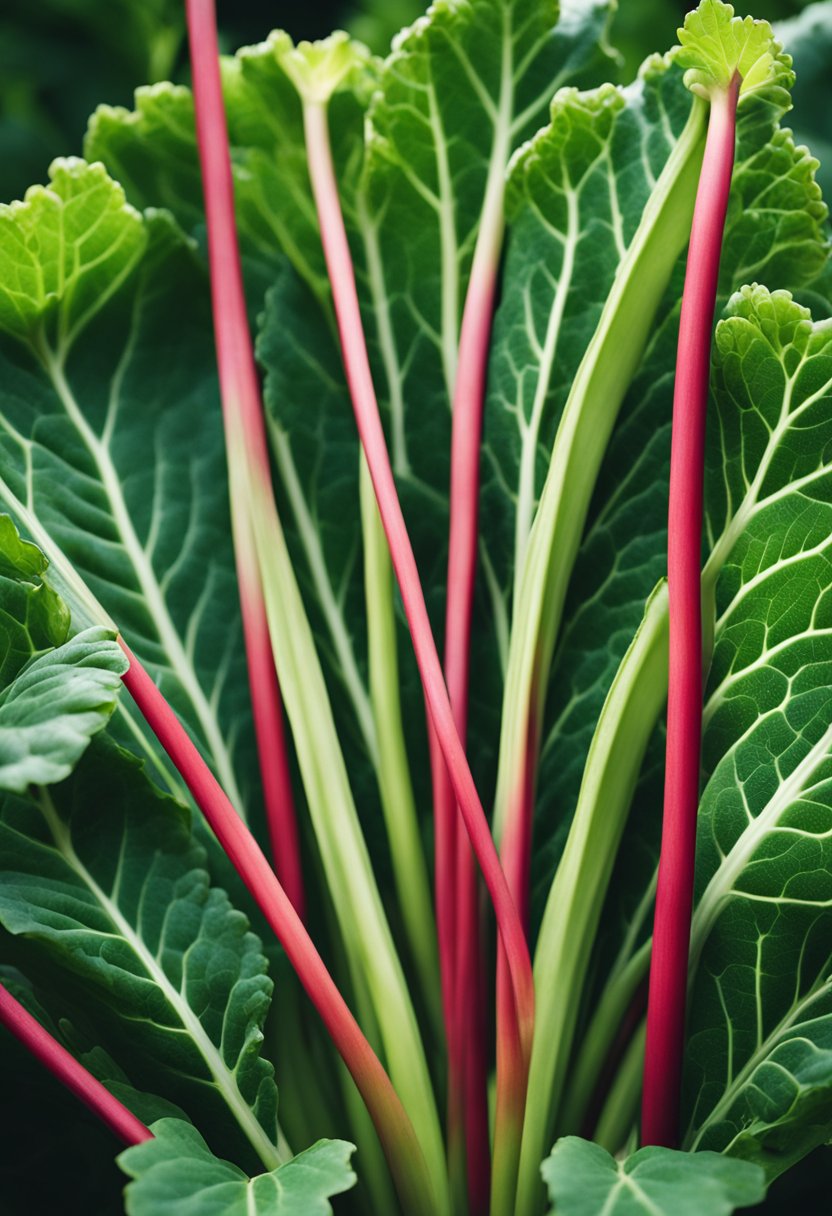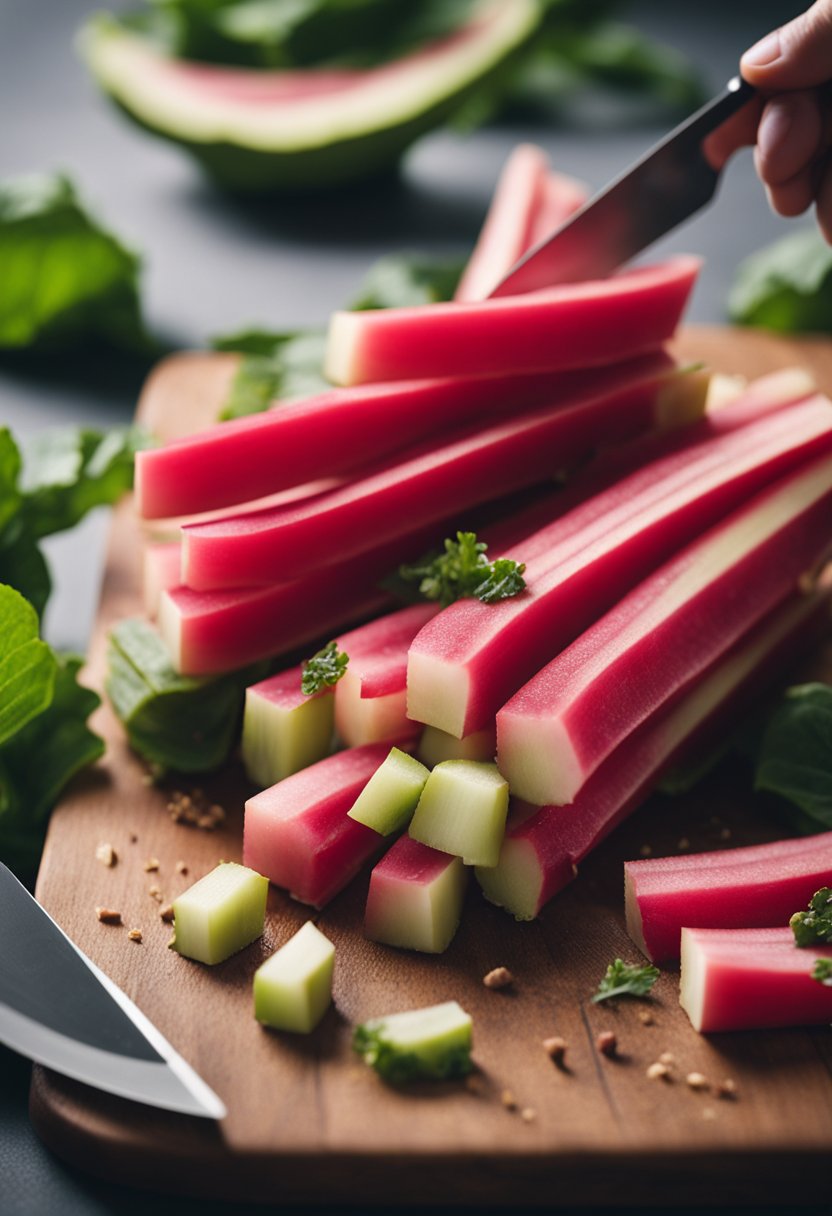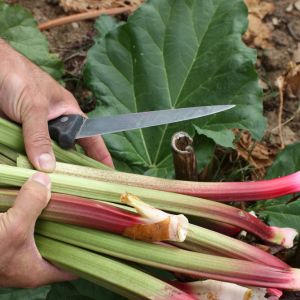If you’re a fan of rhubarb, you may be wondering how to divide this perennial plant. Dividing rhubarb is a great way to propagate the plant and ensure that it continues to thrive in your garden.
This post may contain affiliate links.
The process is relatively simple, but it’s important to do it correctly to avoid damaging the plant.
To begin, it’s important to choose the right time of year to divide your rhubarb. The best time to divide rhubarb plants is in the early spring, just as new growth is beginning to emerge.
This will give the plant plenty of time to establish itself before the hot summer months. Dividing rhubarb in the fall is also an option, but it’s generally not recommended as the plant may not have enough time to establish before winter.
Understanding Rhubarb and Its Growth Cycle
Characteristics of Rhubarb
Rhubarb is a perennial plant that is typically grown for its edible stalks. The stalks are thick and have a bright red color, with a tart taste that is often used in pies and other desserts.
The leaves of the rhubarb plant are large and green, and they should be avoided since they contain high levels of oxalic acid, which can be toxic.
The Rhubarb Plant’s Life Cycle
Rhubarb is a plant that grows in early spring and can be harvested from late spring to early summer. The plant can grow up to 2-3 feet tall and wide, with large leaves that can reach up to 2 feet in length. Rhubarb typically goes dormant in the winter and comes back to life in the spring.
Perennial Rhubarb Crown Ready to Plant | Easy to Grow, Comes Back Every Year (1 Pack)
Optimal Conditions for Growing Rhubarb
Rhubarb thrives in full sun, but it can also grow in partial shade. The soil should be well-draining and rich in organic matter, with a pH level between 6.0 and 6.8.
You can easily measure the soil pH with this inexpensive soil pH meter. Rhubarb should be planted in a garden bed that is at least 4 feet wide and 1 foot deep, with enough space between plants to allow for proper growth.
To ensure a healthy harvest period, it’s important to care for your rhubarb plant properly. This includes watering it regularly, fertilizing it with a balanced fertilizer in the spring, and mulching around the base of the plant to retain moisture in the soil.
It’s also important to remove any flower stalks that appear, as they can divert energy away from the stalks.
Preparing for Division
Dividing rhubarb is an excellent way to propagate your plants and ensure a bountiful harvest. However, before you begin, it’s important to prepare properly. In this section, we’ll cover when to divide rhubarb and the tools and materials you’ll need.
When to Divide Rhubarb
The best time to divide rhubarb is either in late fall or early spring. Late fall division gives the plants time to establish before winter sets in.
Early spring division is best done before new growth appears, which usually happens in March or April.

Tools and Materials Needed
To divide rhubarb, you’ll need a few basic tools and materials. Here’s what you’ll need:
- Spade or garden fork: You’ll need a spade or garden fork to dig up the plant and divide the roots.
- Mulch: After dividing the rhubarb, you’ll need to mulch the plants to protect them from winter cold and spring frost.
- Compost: Rhubarb plants love compost, so be sure to add some to the soil when replanting.
Make sure your spade or garden fork is clean and sharp before you begin. A dull or dirty tool can damage the plant and make the job more difficult.
With the right tools and timing, dividing rhubarb can be a simple and rewarding process. Happy gardening!
The Division Process
Dividing rhubarb is a great way to keep your plants healthy and productive. Here are the steps to follow for a successful division process.
Splitting the Crowns
The first step in dividing rhubarb is to split the crowns. To do this, you will need a garden fork and a sharp knife.
Start by digging around the rhubarb plant with the garden fork, being careful not to damage the roots. Once you have loosened the soil, gently lift the plant out of the ground.
Next, use the knife to split the crown into sections. Each section should have at least one healthy shoot and a good root system. Be sure to cut cleanly through the crown to avoid damaging the plant.

Replanting Rhubarb Sections
Once you have split the crowns, it’s time to replant the rhubarb sections. Choose a location in your garden that gets plenty of sun and has well-drained soil. Dig a hole for each section, making sure it is deep enough to accommodate the roots.
Add some organic matter to the hole, such as compost or well-rotted manure, to help the plant establish itself. Place the rhubarb section in the hole and backfill with soil, firming it down gently.
Water the newly planted rhubarb sections thoroughly, and continue to water regularly until they are well established. With proper care, your divided rhubarb plants should thrive and produce a bountiful harvest for years to come.
Caring for New Rhubarb Plants
Congratulations on your new rhubarb plants! Proper care is essential to ensure that they thrive and produce a bountiful harvest. Here are some tips on how to care for your new rhubarb plants.
Watering and Feeding
Rhubarb plants require consistent moisture to grow properly. Make sure to water your plants regularly, especially during dry spells. However, be careful not to overwater them as this can lead to root rot.
In addition to watering, feeding your rhubarb plants is also important. You can use a balanced fertilizer or well-rotted manure to provide the necessary nutrients. Apply the fertilizer or manure in the spring and again in the fall for best results.
Mulching and Protecting from Cold
Mulching is a great way to retain moisture and suppress weeds around your rhubarb plants. Apply a layer of mulch, such as straw or shredded leaves, around the base of the plants. This will also help keep the soil temperature stable, which is important for rhubarb plants.
During the winter months, it’s important to protect your rhubarb plants from the cold. You can cover them with a layer of straw or other protective material to prevent damage from frost and freezing temperatures. Just make sure to remove the coverings in the spring when the weather warms up.
Harvesting and Utilization of Rhubarb
When and How to Harvest
Rhubarb is a vegetable that is harvested in the spring and early summer. The best time to harvest rhubarb is when the stalks are about 10-15 inches long and are still firm.
To harvest rhubarb, you should grasp the stalk near the base and pull it out of the ground with a twisting motion. Be sure to leave a few stalks on the plant so that it can continue to produce.
Rhubarb in the Kitchen
Rhubarb is a versatile vegetable that can be used in a variety of dishes. One of the most popular ways to use rhubarb is in pies. Rhubarb pie is a classic dessert that is easy to make and always delicious. Rhubarb can also be used to make jams, jellies, and sauces.
It’s important to note that rhubarb contains oxalic acid, which can be harmful if consumed in large quantities. However, the amount of oxalic acid in rhubarb is relatively low, and it is safe to eat in moderation.
To reduce the amount of oxalic acid in rhubarb, you can remove the leaves before cooking.
If you have rhubarb plants in your garden, it’s important to keep them productive by dividing them every few years. To divide rhubarb plants, you should dig up the entire plant and then separate the individual crowns.
Each crown should have at least one bud and a few healthy roots. Replant the crowns in a new location with well-drained soil and plenty of sunlight.
Frequently Asked Questions
When is the best time to divide rhubarb plants?
The best time to divide rhubarb plants is during the fall or early spring when the plant is dormant. This will give the plant enough time to establish itself before the next growing season.
What steps should I follow to divide rhubarb in the fall?
To divide rhubarb in the fall, follow these steps:
- Dig up the entire plant, being careful not to damage the roots.
- Use a sharp knife or garden shears to separate the plant into sections, making sure each section has at least one healthy bud and a good root system.
- Replant the sections in well-draining soil, making sure the crown of the plant is level with the soil surface.
- Water the newly transplanted rhubarb thoroughly and keep the soil moist until the plant becomes established.
Can I divide and transplant rhubarb during the summer?
While it’s possible to divide and transplant rhubarb during the summer, it’s not recommended. Rhubarb plants are more likely to experience transplant shock during the summer months, which can stunt their growth and reduce their overall health.
What’s the proper way to divide rhubarb when it’s grown in pots?
To divide rhubarb that’s grown in pots, follow these steps:
- Carefully remove the plant from the pot, being sure not to damage the roots.
- Use a sharp knife or garden shears to separate the plant into sections, making sure each section has at least one healthy bud and a good root system.
- Replant the sections in fresh potting soil, making sure the crown of the plant is level with the soil surface.
- Water the newly transplanted rhubarb thoroughly and keep the soil moist until the plant becomes established.
How can I prevent transplant shock when moving rhubarb?
To prevent transplant shock when moving rhubarb, be sure to keep the roots moist and handle the plant gently. Make sure the new planting site has well-draining soil and is free of weeds and other plants that could compete with the rhubarb for nutrients.
What are the tips for encouraging rhubarb to multiply?
To encourage rhubarb to multiply, make sure the plant is growing in a location with full sun and well-draining soil. Fertilize the plant in the spring with a balanced fertilizer, and water it regularly during dry spells.
Avoid harvesting the plant during its first year of growth, and only harvest a maximum of one-third of the plant’s stalks in subsequent years.
Follow my gardening board on Pinterest.




